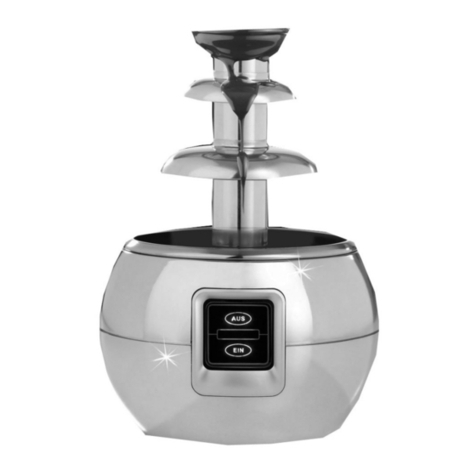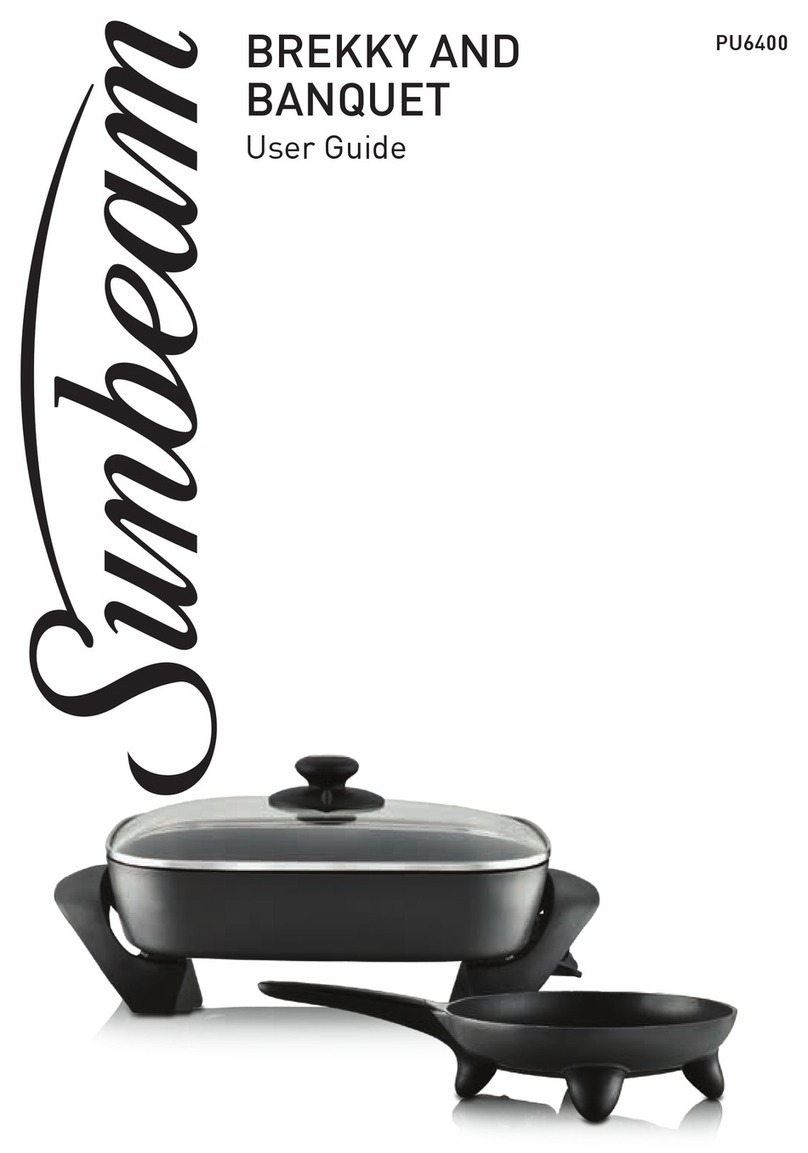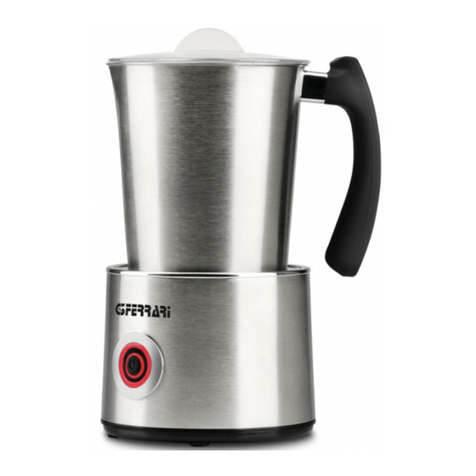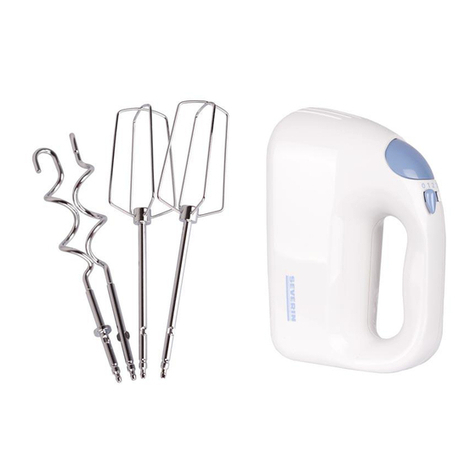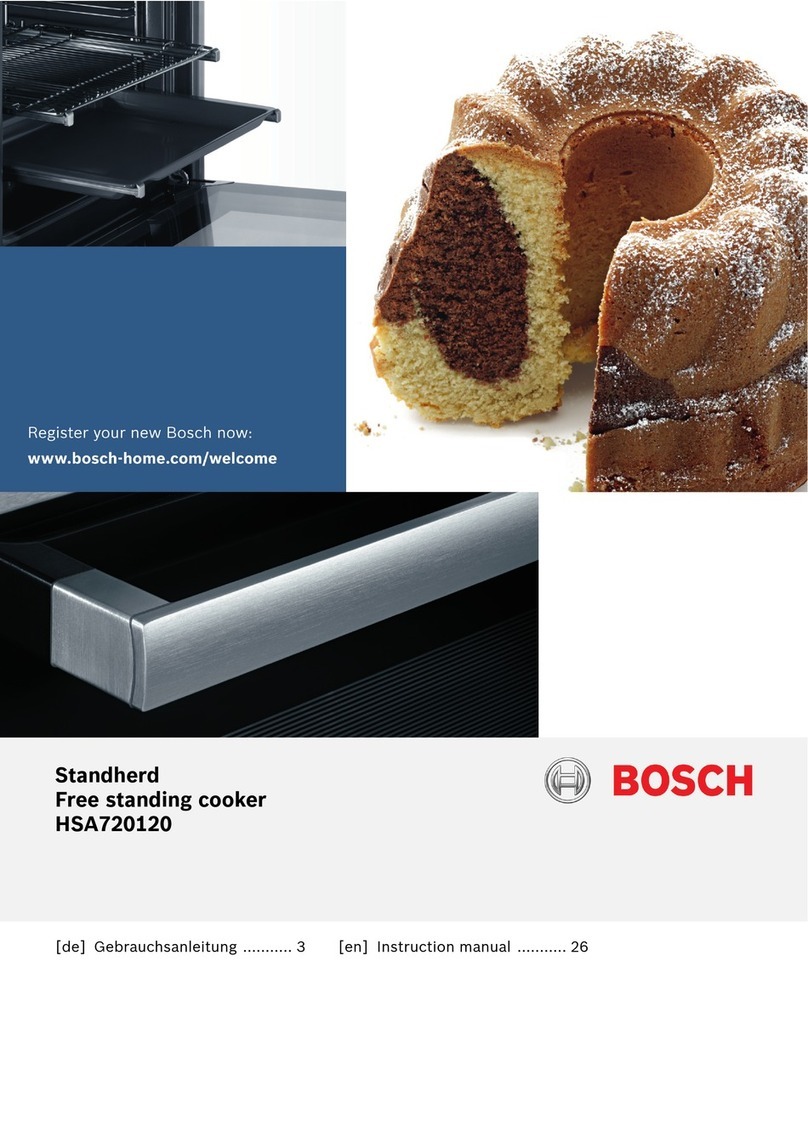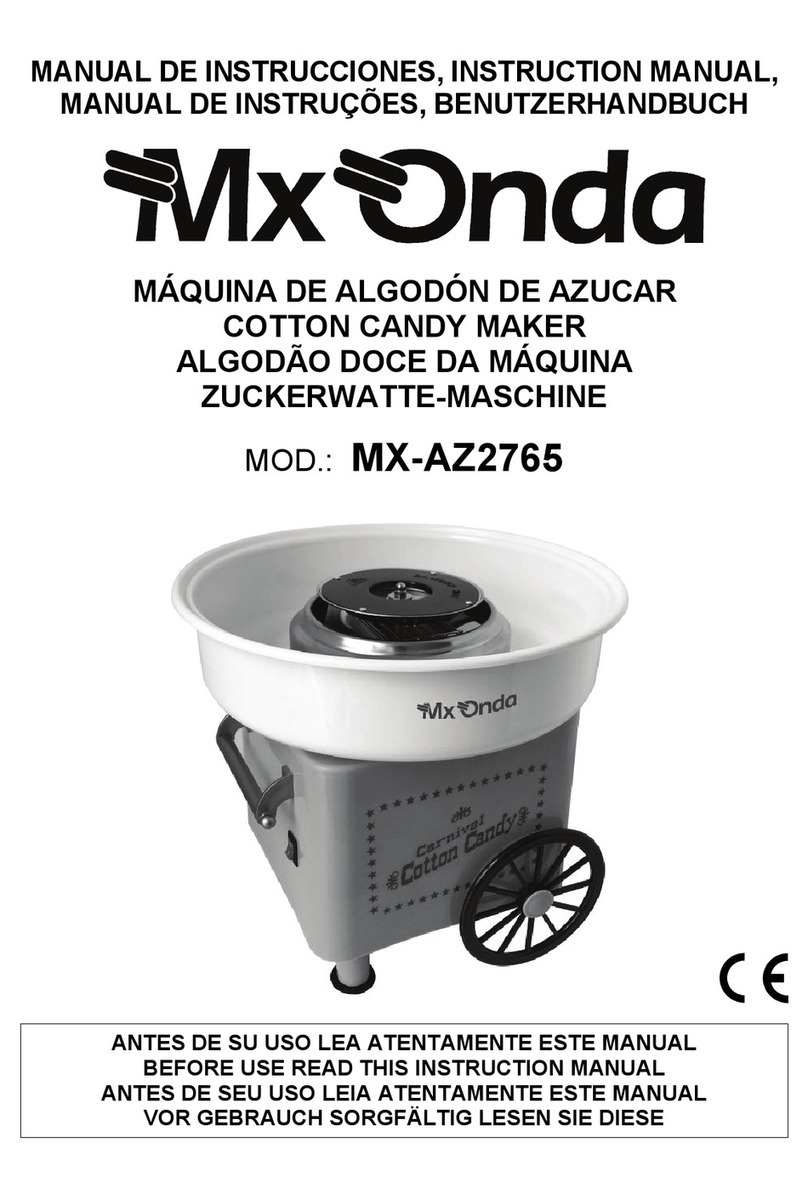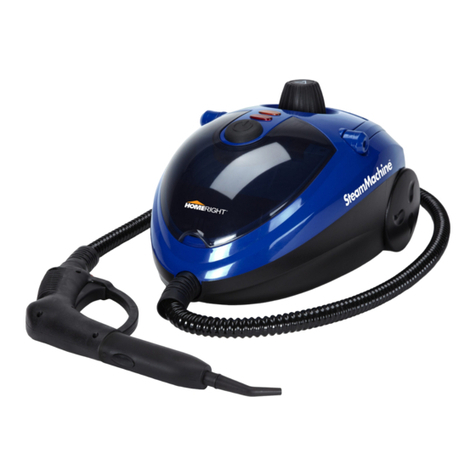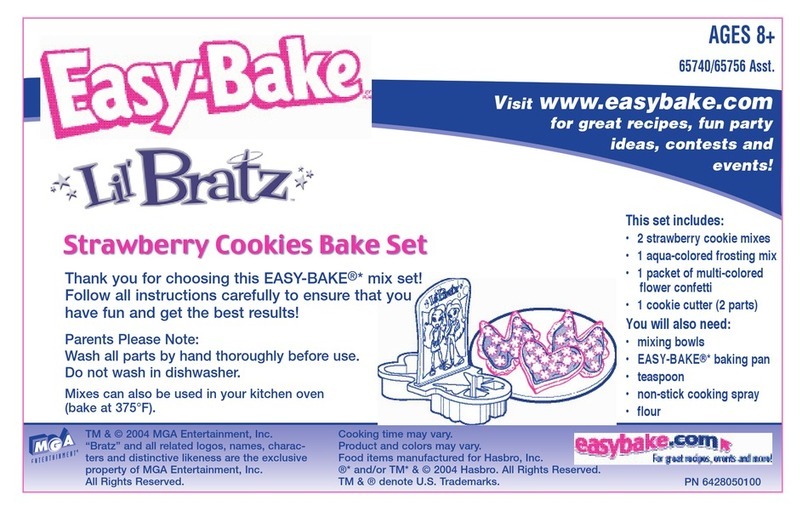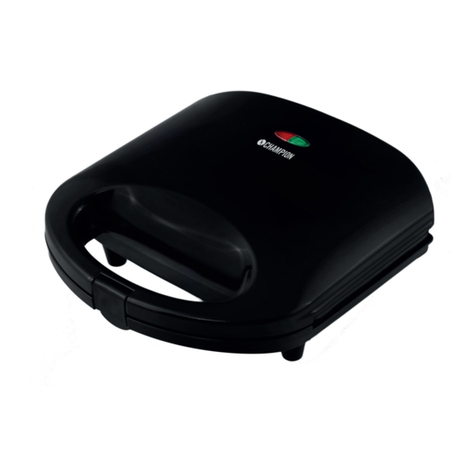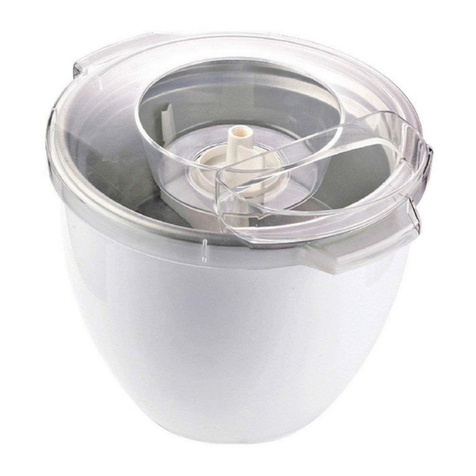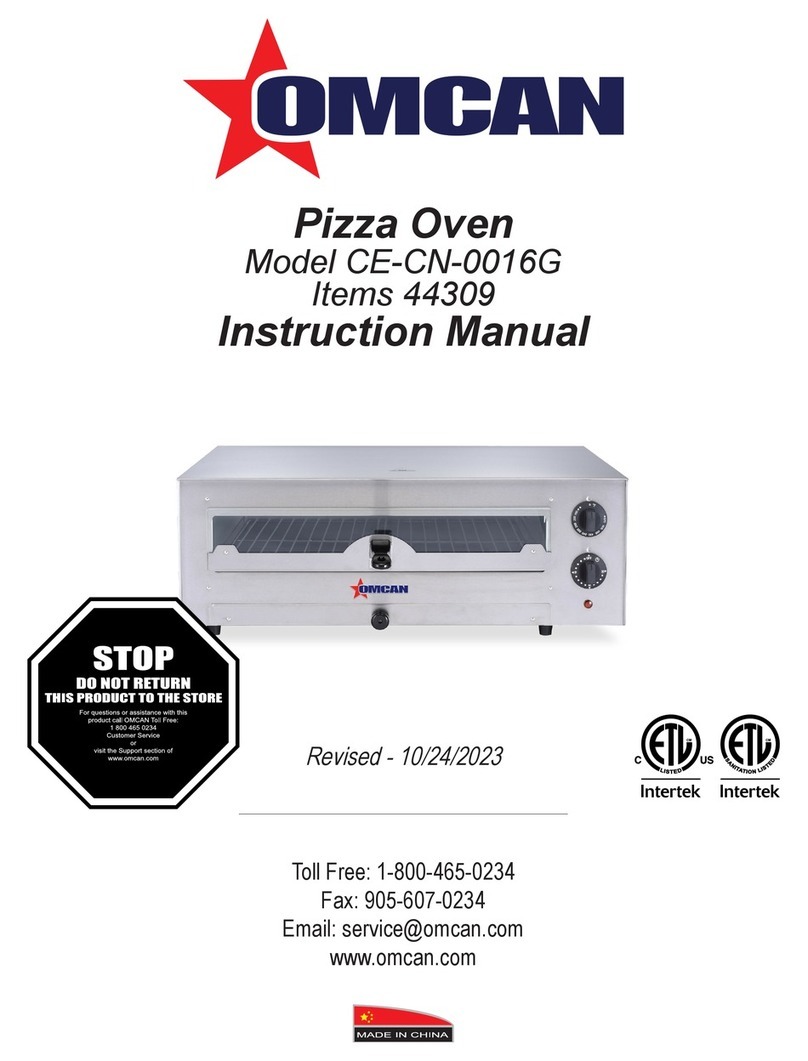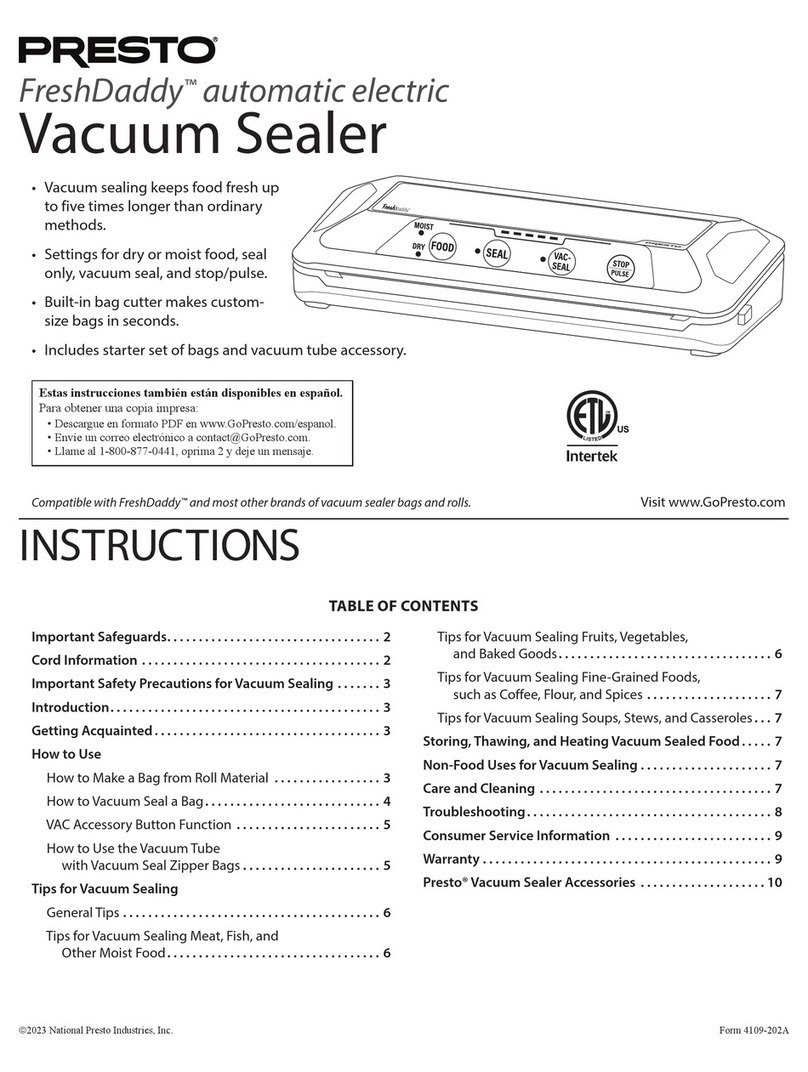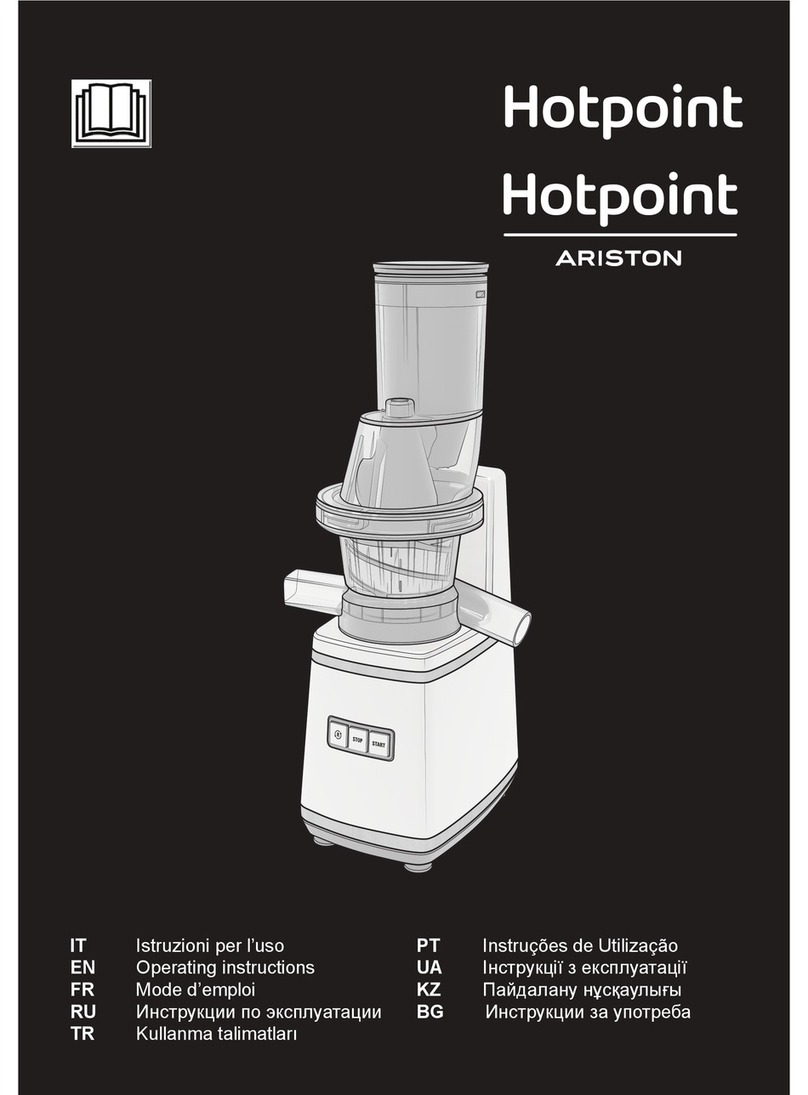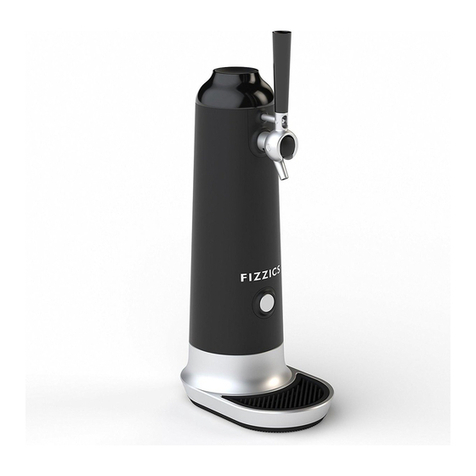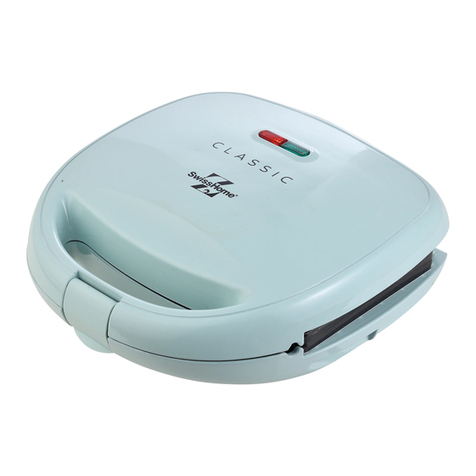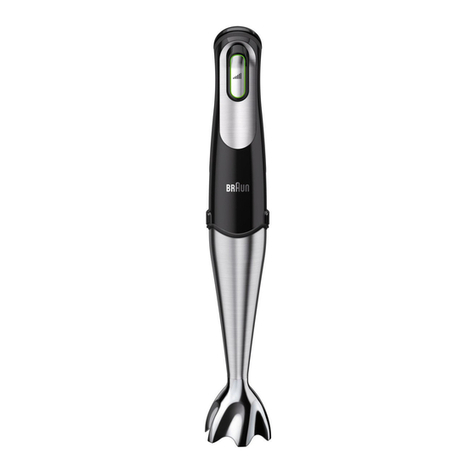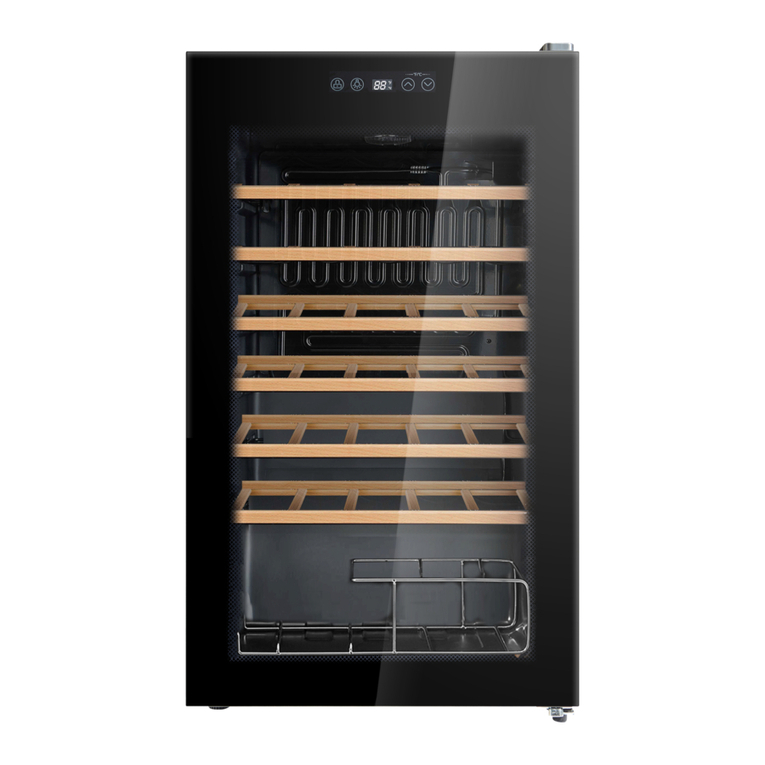Even Embers GAS2540AS User manual

5 Burner Gas Griddle
OWNER’S MANUAL
ASSEMBLY AND OPERATING INSTRUCTIONS
WARNING
HAZARDOUS EXPLOSION MAY RESULT IF THESE
WARNINGS AND INSTRUCTIONS ARE IGNORED. READ AND
FOLLOW ALL WARNINGS AND INSTRUCTIONS IN THIS
MANUAL TO AVOID PERSONAL INJURY, INCLUDING DEATH
OR PROPERTY DAMAGE.
NOTICE TO INSTALLER:
LEAVE THESE INSTRUCTIONS WITH
THE GRIDDLE OWNER FOR FUTURE
REFERENCE.
SAVE THIS MANUAL FOR FUTURE REFERENCE
Model GAS2540AS

1
WE WANT YOU TO ASSEMBLE AND USE YOUR Griddle AS SAFELY AS POSSIBLE.
THE PURPOSE OF THIS SAFETY ALERT SYMBOL IS TO ATTRACT YOUR ATTENTION
TO POSSIBLE HAZARDS AS YOU ASSEMBLE AND USE YOUR Griddle.
WHEN YOU SEE THE SAFETY ALERT SYMBOL
PAY CLOSE ATTENTION TO THE INFORMATION WHICH FOLLOWS!
READ ALL SAFETY WARNINGS AND INSTRUCTIONS CAREFULLY
BEFORE ASSEMBLING AND OPERATING YOUR Griddle.
DANGER
IMPORTANT SAFETY
WARNINGS
IF YOU SMELL GAS:
1. Shut off gas to the appliance.
2. Extinguish any open ame.
3. Open lid.
4. If odor continues, keep away from the appliance and immediately call your gas supplier or your
re department.
1. Do not store or use gasoline or other ammable liquids or vapors in the vicinity of this or any
other appliance.
2. An LP cylinder not connected for use shall not be stored in the vicinity of this or any other
appliance.
a) Do not store a spare LP cylinder under or near this appliance.
b) Never ll the cylinder beyond 80% full.
c) If the information in (a) and (b) is not followed exactly, a re causing death or
serious injury may occur.
WARNING
DANGER

2
General Warnings . . . . . . . . . . . . . . . . . . . . . . . . . . . . . . . . . . . . . . . . . . . . 3-4
LP Gas Cylinder (Tank) Specications and Installation . . . . . . . . . . . . . . . . 4-6
Hose & Regulator Specications and Installation . . . . . . . . . . . . . . . . . . . . 6-7
Leak Testing. . . . . . . . . . . . . . . . . . . . . . . . . . . . . . . . . . . . . . . . . . . . . . . . . 7-8
Pre-start Check List . . . . . . . . . . . . . . . . . . . . . . . . . . . . . . . . . . . . . . . . . . . . .9
Lighting Instructions . . . . . . . . . . . . . . . . . . . . . . . . . . . . . . . . . . . . . . . . . . 9-10
Operating the Griddle. . . . . . . . . . . . . . . . . . . . . . . . . . . . . . . . . . . . . . . . 10-11
Proper Care and Maintenance . . . . . . . . . . . . . . . . . . . . . . . . . . . . . . . . . 11-12
Transporting and Storage. . . . . . . . . . . . . . . . . . . . . . . . . . . . . . . . . . . . . . . .13
Trouble Shooting . . . . . . . . . . . . . . . . . . . . . . . . . . . . . . . . . . . . . . . . . . . 14-15
Griddle Cooking Tips . . . . . . . . . . . . . . . . . . . . . . . . . . . . . . . . . . . . . . . . . . .15
Assembly Instructions . . . . . . . . . . . . . . . . . . . . . . . . . . . . . . . . . . . . . . . 16-23
Warranty Information . . . . . . . . . . . . . . . . . . . . . . . . . . . . . . . . . . . Back Cover
DANGER: Indicates an imminently hazardous situation which, if not avoided, will result in death or serious injury.
WARNING: Be alert to the possibility of serious bodily injury if the instructions are not followed. Be sure to read and
carefully follow all of the messages.
CAUTION: Indicates a potentially hazardous situation which, if not avoided, may result in minor or moderate injury.
TABLE OF CONTENTS:
CALIFORNIA PROPOSITION 65 WARNING
WARNING: This product can expose you to chemicals, including carbon monoxide, which are
known to the State of California to cause birth defects or other reproductive harm.
For more information go to www.P65Warnings.ca.gov
WARNING: CONTAINS LEAD. MAY BE HARMFUL IF EATEN OR CHEWED. COMPLIES WITH
FEDERAL STANDARDS. KEEP OUT OF REACH OF CHILDREN.

3
WARNING
• Leak test all connections before rst use, even if griddle was purchased fully assembled and after
each tank rell. Check the propane tank rubber seal for damage.
• Always check the unit and propane tank prior to each use as indicated in the “Checking for Leaks” &
“Pre-Start Check List” sections of this manual.
• Never use natural gas in a unit designed for liquid propane gas.
• Flavoring chips must be contained in a metal smoking box to contain ash and prevent res.
• Ensure ames come out of all burner ports at each use. Spiders and insects like to build nests in
burner tubes. Blocked burner tubes can prevent gas ow to the burners and could result in a burner
tube re or re behind the control panel.
• Never check for leaks using a match or open ame.
• Never use or store gasoline, lighter uid, paint thinner, or other ammable vapors and liquids or
combustible materials in or near your griddle.
• DO NOT block ventilation areas in sides, back or cart compartment of griddle.
• Never place more than 10 pounds on the side tables. DO NOT lean on the side tables. DO NOT lift
griddle using side tables.
• Keep children and pets away from hot griddle. DO NOT allow children to use or play near this griddle.
• DO NOT leave the griddle unattended while ON or in use.
• DO NOT allow the gas hose to come in contact with hot surfaces. Redirect the gas hose if necessary.
• DO NOT allow grease or hot drippings to fall on hose and regulator assembly. If this occurs, turn gas
supply OFF at once. Empty grease tray/cup and clean the hose and regulator assembly and inspect
for damage before use.
• Never cook on the griddle without the grease cup/tray in position.
• Adding a large amount of cold or frozen food (or food with signicant water content) to a hot griddle
may cause griddle to warp.
• A slight warp may develop during heating and cooling of the griddle but should not affect the
performance.
• Keep any electrical supply cords away from water or heated surfaces.
• DO NOT use water on a grease re. Closing the lid to extinguish a grease re is not possible. Use
type BC dry chemical re extinguisher or smother with dirt, sand or baking soda.
• DO NOT use while under the inuence of drugs or alcohol.
• FOR OUTDOOR USE ONLY. DO NOT operate indoors or in an enclosed area such as a building,
garage, shed or breezeway.
• Apartment dwellers: Check with management and follow the requirements and re codes for using an
LP gas griddle in your apartment complex.
• Maintain a minimum clearance of 36 inches (91 cm) between back and all sides of griddle, deck
railings, walls or other combustible material. Not adhering to these clearances may prevent proper
ventilation and can increase the risk of a re and/or property damage, which could also result in
personal injury. DO NOT use griddle under overhead combustible construction.
• DO NOT use or install this griddle in or on a recreational vehicle and/or boat.
• DO NOT build this model griddle in any built-in or slide in construction.
• If a bristle brush is used to clean any of the cooking surfaces, ensure no loose bristles remain on the
cooking surfaces prior to grilling as loose bristles may attach to food.
• DO NOT store items in cart that can catch re or damage your griddle (such as swimming pool
supplies/chemicals, table cloth, wood chips).
GENERAL WARNINGS:

4
LP GAS CYLINDER (TANK) SPECIFICATIONS AND INSTALLATION:
• Griddle is hot when in use. To avoid burns:
• DO NOT attempt to move the griddle.
• Block the wheels so the unit does not accidentally move.
• Wear protective gloves or oven mitts.
• DO NOT touch any hot griddle surfaces.
• DO NOT wear loose clothing or allow hair to come in contact with griddle.
• Not for commercial use. DO NOT use this griddle for anything other than its intended purpose.
USE CAUTION AND COMMON SENSE WHEN OPERATING YOUR GAS GRIDDLE.
FAILURE TO ADHERE TO THE SAFETY WARNINGS AND GUIDELINES IN THIS MANUAL
COULD RESULT IN SEVERE BODILY INJURY OR PROPERTY DAMAGE.
SAVE THIS MANUAL FOR FUTURE REFERENCE.
WARNING
• ONLY connect this griddle to a Type 1 cylinder valve. The Type 1 valve can be identied with the
large external threads on the valve outlet.
• DO NOT connect to a propane cylinder exceeding a 20 lb. (9.1 kg) capacity.
• DO NOT connect to a cylinder that uses any other type of valve connection device.
• Inspect the propane tank valve rubber seal for cracks, wear or deterioration prior to use. A
damaged rubber seal can cause a gas leak, possibly resulting in an explosion, re or severe
bodily harm.
• Turn off the cylinder valve when your griddle is not in use.
• Handle the tank with care.
• Always secure the cylinder in an upright position.
• Never connect an unregulated LP gas cylinder to your griddle.
• DO NOT expose LP gas cylinders to excessive heat or ignition sources.
• DO NOT store a spare LP gas cylinder under or near your griddle.
• Allow only qualied LP gas dealers to ll or repair your LP gas cylinder.
• DO NOT allow the cylinder to be lled beyond 80% capacity.
• Read and follow all warnings and instructions that are on the cylinder and that accompany this
product.
• DO NOT store a spare LP gas cylinder (full or empty) under or near your griddle. This could
cause excess pressure to be expelled through the vapor relief valve resulting in re, explosion,
or severe personal injury, including death.
• Propane gas is heavier than air and will collect in low areas. Proper ventilation is extremely
important. Keep the ventilation opening(s) of the LP gas cylinder enclosure free and clear from
obstructions and debris.
• DO NOT insert any foreign objects into the cylinder valve outlet as this could damage the
rubber seal. Do not use propane tank with a damaged rubber seal. A damaged rubber seal can
cause a gas leak, possibly resulting in explosion, re, severe bodily harm, or death. Inspect
rubber seal for cracks, wear or deterioration prior to use.
• Always keep cylinder (tank) in upright position during use, transit or storage.
DANGER

5
• Allow only qualied licensed LP gas dealers to properly ll or repair your LP gas cylinder.
• New tanks should be purged prior to lling; inform LP gas dealer if you are using a new tank.
• DO NOT allow the cylinder to be lled beyond 80% capacity. Over-lled tanks can create a
dangerous condition. Over-lled tanks can build-up pressure and cause the relief valve to expel
propane gas vapors. The vapor is combustible and if it comes in contact with a spark source or
ame an explosion causing severe burns, bodily harm, or death could occur.
• Always use a protective cylinder cap when griddle is not connected to cylinder.
• If you exchange a cylinder with a qualied exchange program, the new cylinder must have
a Type 1 valve and an over-lling prevention device (OPD).
• Inspect the propane tank valve rubber seal for cracks, wear or deterioration prior to use. A
damaged rubber seal can cause a gas leak, possibly resulting in an explosion, re or severe
bodily harm.
FILLING THE LP GAS CYLINDER (TANK):
WARNING
LP GAS CYLINDER (TANK) SPECIFICATIONS:
LP gas cylinder (not supplied with this griddle)
The LP (Liquid Propane) gas cylinder specically designed to be used with this griddle must be 12” (30.5
cm) diameter x 18” (45.7 cm) tall and have a 20 lb. (9.1 kg) capacity incorporating a Type 1 cylinder valve
and an over-lling protection device (OPD).
This griddle is designed to t Worthington, Manchester or SMPC brand 20 lb. (9.1 kg) cylinders. Other
brand DOT cylinders may t this griddle if the cylinder has similar dimensions of the top and bottom rings.
The installation of this appliance must be in accordance with:
All applicable local codes, or in the absence of local codes, either:
• National Fuel Gas Code ANSI Z223.1 NFPA 54
• Natural Gas and Propane Installation Code: CAN/CGA B149.1
• Natural Gas Installation Code: CAN/CGA B149.1 (Canada)
• Propane Installation Code: CAN/CGA B149.2 (Canada)
To check your local codes, see your local LP gas dealer or natural gas company. This griddle was not
intended to be connected to a natural gas supply line. If an external electrical source is utilized, it must be
electrically grounded in accordance with local codes, or in the absence of local codes, with the National
Electrical Code, ANSI/NFPA 70, or the Canadian Electrical Code, CSA 22.1.
When purchasing or exchanging a cylinder for your gas griddle, it must be constructed and marked in
accordance with the specications for LP gas cylinders of the U.S. Department of Transportation (DOT)
or the National Standard of Canada, CAN/CSA-B339 Cylinders, Spheres and Tubes for Transportation of
Dangerous Goods; and Commission, as applicable; and provided with a listed over-lling prevention device
(OPD), and provided with a cylinder connection device compatible with the connection for outdoor cooking
appliances.
The cylinder must also be equipped with:
• A shut-off valve terminating in a Type 1 gas cylinder valve outlet.
• A Type 1 valve that prevents gas ow until a positive seal is obtained.
• An arrangement for vapor withdrawal.
• A collar to protect the cylinder shut-off valve.
• A safety relief device having direct communication with the vapor space of the cylinder.
• A listed over-lling prevention device (OPD).

Upper Tank Holder
6
INSTALLING THE LP GAS CYLINDER (TANK) ONTO THE GRIDDLE:
1. Check that the cylinder valve is closed by turning the knob clockwise. Inspect cylinder valve rubber seal
for cracks or deterioration. Do not use propane tank with damaged seal as a gas leak may occur.
2. Support the cylinder on the upper and lower tank holders on right side of cart.
3. Orient the cylinder such that the valve opening faces the front of the griddle and the hose is not kinked
or damaged.
• Inspect the propane tank valve rubber seal for cracks,
wear or deterioration prior to use. A damaged rubber
seal can cause a gas leak, possibly resulting in an
explosion, re or severe bodily harm.
• Inspection should be done each time the propane tank is
connected to the griddle, has been relled, exchanged or
has not been used for more than 60 days.
• Do not use a propane tank with a damaged rubber seal.
Exchange the tank or have the rubber seal replaced at a
qualied propane lling station.
LP GAS CYLINDER (TANK) RUBBER SEAL INSPECTION:
Good
Rubber Seal
Damaged
Rubber Seal
HOSE & REGULATOR SPECIFICATIONS AND INSTALLATION:
• DO NOT attempt to connect griddle, as purchased for LP (propane) gas, to any other fuel supply
source such as a natural gas line. For dual fuel griddles that can be converted to natural gas, a
Even Embers conversion kit must be purchased and installed for use with natural gas.
• DO NOT use any other pressure regulator/hose assembly other than the one supplied with your
griddle. Replacement pressure regulator/hose assembly must be part No 2540-155-7600-0, which can
be obtained by contacting customer service at 1-855-735-9922.
• DO NOT attempt to adjust or repair a regulator. The regulator is designed to operate at a
maximum output pressure of 11 inches of water column (2.74 kPa).
• Ensure the tank valve is CLOSED prior to connecting the LP gas cylinder to your griddle.
Turn the valve knob clockwise to properly close the valve. Read and follow all instructions
and warnings on the supply hose safety tags. Read and follow all warnings in this manual
concerning the safe use of LP gas cylinders and the hose and regulator before connecting
cylinder to griddle. Read and follow all warnings on the LP cylinder.
WARNING
Lower Tank Holder

7
HOSE AND REGULATOR:
Your griddle is equipped with a Type 1 connection device with the following features:
1. The system will not allow gas ow from the cylinder until a positive connection to the valve has been made.
Note: The cylinder valve and all griddle burner knobs must be turned OFF before any connection is made
or removed.
2. A regulator ow limiting device, when activated, restricts the ow of gas to 10 cubic feet per hour. If the
ow limiting device is activated, perform Regulator Resetting Procedure.
Note: If your griddle will not get hot enough to cook, the ow limiting device may have been activated.
CONNECTING HOSE AND REGULATOR:
1. Inspect the propane tank valve rubber seal for cracks, wear or
deterioration prior to use. A damaged rubber seal can cause a gas
leak, possibly resulting in an explosion, re or severe bodily harm. Do
not use a propane tank with a damaged rubber seal.
2. Attach or detach regulator to the LP gas cylinder only when cylinder is
at rest in tank holder.
3. Check that the cylinder valve is closed by turning the knob clockwise.
4. Check that the griddle’s burner control knobs are in the “OFF” positions.
5. Visually inspect the hose assembly prior to each use for evidence of
damage, excess wear, or deterioration. If found, replace the assembly
before using your griddle. Only the manufacturer’s supplied replacement should be used.
6. Remove the protective plastic cap from the cylinder valve.
7. Check that the hose does not contain kinks, does not contact sharp edges, and does not contact
surfaces that may become hot during use.
8. Hold regulator and insert the brass nipple into the LP cylinder valve outlet. Ensure that the device is
centered properly.
9. Turn the large coupling nut clockwise by hand and tighten to a full stop. Take care not to cross thread
the coupling nut onto the cylinder valve. Do not use tools to tighten connection.
Note: If you are unable to make the connection, repeat Steps 7 and 8.
10. Leak check all ttings before lighting your griddle. See section on “Leak Testing” in this manual.
Note: To remove regulator from propane tank, turn off the tank valve and rotate the large coupling nut
counter-clockwise and remove.
REGULATOR RESETTING PROCEDURE:
If your griddle will not get hot enough to cook, the ow limiting device may have been activated.
Mini Reset:
Turn ALL burner control knobs to “OFF”, turn off the cylinder valve. Wait one minute. Slowly turn
cylinder valve ON and relight griddle. If burner ame is higher and griddle heats up properly – proceed
with cooking.
Full Reset:
Turn ALL burner control knobs to “OFF”, turn off the cylinder valve. Disconnect hose and regulator from
cylinder. Wait two minutes, reattach hose and regulator and perform leak test.
WARNING
• Never use your griddle without leak testing all gas connections, hoses and propane tank. Follow
the section on “Leak Testing” in this manual for proper procedures.
LEAK TESTING:
Inspect Rubber Seal (see page 6)

To prevent re or explosion hazard:
• DO NOT smoke or permit ignition sources in the area while conducting a leak test.
• Perform test OUTDOORS in a well ventilated area that is protected from the wind.
• Never perform a leak test with a match or open ame.
• Never perform a leak test while the griddle is in use or while griddle is still hot.
DANGER
WHEN TO PERFORM A LEAK TEST:
• After assembling your griddle and before lighting for the rst time, even if purchased fully assembled.
• Every time the LP gas cylinder is relled, exchanged or if any of the gas components are disconnected or
replaced.
• Any time your griddle has been moved.
• At least once per year or if your griddle has not been used for more than 60 days.
CHECKING FOR LEAKS:
CAUTION: Strong odors, colds, sinus congestion, etc. may prevent the detection of propane by smell.
Use caution and common sense when testing for leaks.
Note: The leak test must be performed in an area that has adequate lighting in order to see if bubbles are
developing and not in a windy or noisy area so larger leaks can be detected by smell or sound.
1. Create a mixture of 50% water and 50% liquid dishwashing soap.
2. Open the lid.
3. Ensure all control knobs are set to the “OFF” position.
4. Turn on the gas at the cylinder valve. Turn the cylinder valve knob
counter-clockwise to full open. If you hear a rushing sound or smell gas,
turn the gas off. Tighten any leaking connections. If leak is detected at
connection nut and tightening does not stop leak, reinspect propane tank
rubber seal.
5. Apply the soapy water mixture to the following:
Supply tank (cylinder) weld.
Connection nut to tank valve.
Back side of connection nut to brass nipple.
Brass nipple connection into regulator.
Regulator connections to gas supply hoses.
Hose connection to gas manifold.
The full length of gas supply hose.
Tank valve to cylinder.
6. Check each place listed (A–H) for growing bubbles, which indicates a
leak. Large leaks may not be detected by bubbles but should produce a
rushing sound or gas smell.
7. Turn off gas supply at cylinder valve.
8. Turn on control knobs to release gas pressure in hose.
9. Turn control knobs to “OFF” position.
10. Tighten any leaking connections. If leak is detected at connection nut and
tightening does not stop leak, reinspect propane tank rubber seal. (see
page 6)
11. Repeat soapy water test until no leaks are detected.
12. Turn off gas supply at cylinder valve until you are ready to use your
griddle.
13. Wash off soapy residue with cold water and towel dry.
14. Wait 5 minutes to allow all gas to evacuate the area before lighting
griddle.
WARNING: DO NOT use the griddle if leaks cannot be stopped. Contact a
qualied gas appliance repair service.
8
A
B
C
D
E
F
G
H
Watch For Bubbles
F
G
H
E
D
C
B
A

9
LIGHTING THE MAIN BURNERS:
1. Open lid before lighting burner.
2. Make sure all control knobs are in the “OFF” position.
3. Select burner to be lit. Push and turn control knob to “HIGH”. Push and
hold the igniter for 3 - 5 seconds.
4. If ignition does NOT occur in 5 seconds, turn control knob to “OFF”,
wait 5 minutes to allow gas to dissipate and repeat lighting procedure.
5. To light other burners, follow steps 3-4.
6. If burner does not ignite using the igniter, see “Match Lighting the Main Burners” section.
7. To turn off, turn each control knob clockwise until it locks in the “OFF” position. This does not turn off
the gas ow from the cylinder.
Note: If burner does not light or ame is too low, See “Trouble Shooting” section of the owners manual.
WARNING
DANGER
Property damage, bodily harm, severe burns, and death could result from failure to follow these
safety steps. These steps should be performed after the griddle has been assembled and prior to
each use. DO NOT operate this griddle until you have read and understand ALL of the warnings and
instructions in this manual.
• Ensure that the griddle is properly assembled.
• Inspect the gas supply hose for burns, chaffing, kinks, and proper routing before each use. If it is
evident there is excessive abrasion or wear, or the hose is cut, it must be replaced prior to the griddle
being used. Replace with hose and regulator Model No. 2540-155-7600-0, which can be obtained by
contacting customer service at 1-855-735-9922.
• Leak check all gas connections, hose and propane tank. See section on “Leak Testing”.
• Ensure that all electrical supply cords are properly grounded. Keep any electrical supply cord and the
fuel supply hose away from any heated surfaces. Hose should be at least 3 inches from hot surfaces.
• Position your griddle on a non-combustible level surface in a well ventilated location, a safe distance
from combustible materials, buildings and overhangs.
• Properly place the empty grease cup under the grease drain hole in the bottom of the griddle to catch
grease during use.
• DO NOT block ventilation areas in sides, back or cart compartment of griddle.
PRE-START CHECK LIST:
GAS LIGHTING INSTRUCTIONS:
Read, understand and follow all warnings and instructions contained in this manual. DO NOT skip any
of the warnings and instructions contained in the preceding sections of this manual.
Follow the instructions exactly.
1. Open the griddle lid before attempting to light a burner so that fumes do not accumulate inside
the griddle. An explosion could occur if griddle lid is down.
2. Check that all burner control knobs and the cylinder valve are turned to the “OFF” position.
3. Turn on the fuel supply by slowly rotating the cylinder valve knob counter-clockwise to full open.
4. DO NOT stand with head, body, or arms over the griddle when lighting.

10
MATCH LIGHTING THE MAIN BURNER:
1. Open lid before lighting burner.
2. Make sure all control knobs are in the “OFF” position.
3. Place a paper match in the end of the matchlighter. Strike the match
and place the match as shown approximately 1/2” (1 to 2 cm) from the
burner to be lit.
4. Turn the burner control knob to the “HIGH” position. The burner should
light within 5 seconds.
5. If the burner does not light, turn the control knob to “OFF” and wait 5 minutes
for gas to dissipate and repeat lighting procedure.
6. Once lit, light adjacent burners by following steps 3-6.
7. If the burner does not light within the rst few attempts of match lighting, there is a problem with the
gas supply. Turn off the gas at the burner and cylinder. DO NOT attempt to operate the griddle until the
problem is found and corrected.
Note: If burner does not light or ame is too low, See “Trouble Shooting” section of the owners manual.
Matchlighter
• Read and follow all warnings and instructions contained in the preceding sections of this
manual.
• Flavoring chips must be contained in a metal smoking box to contain ash and prevent res.
• DO NOT cover griddle or other components with aluminum foil, as this blocks ventilation and
damage to griddle or personal injury may occur.
• DO NOT leave your griddle unattended while “ON” or in use.
• DO NOT move griddle when in use.
• DO NOT use water on a grease re. Closing the lid to extinguish a grease re is not possible.
Use type BC dry chemical re extinguisher or smother with dirt, sand or baking soda.
• Never cook on the griddle without the grease cup/tray in place.
WARNING
OPERATING THE GRIDDLE:
GRIDDLE SEASONING INSTRUCTIONS:
For best results, we recommend seasoning the griddle before cooking on griddle top.
Step 1 Make sure griddle top is wiped clean of debris (refer to Cleaning Your Griddle)
Step 2 Ignite griddle by following the lighting instructions. Turn all knobs to HIGH and wait 10 to 15 minutes
until your griddle top starts to discolor.
Step 3 Pour 3 tablespoons of oil on griddle top. Any cooking oil will work.
Step 4 Use cooking tongs or heat resistant gloves to hold folded paper towels. Spread the cooking oil over
the surface of griddle top evenly by using the folded paper towel. Be sure to cover every part of the
griddle top (i.e. corners, sides, etc.).
Step 5 Once your griddle is covered with a thin layer of cooking oil, allow griddle to heat on HIGH. Smoking
will occur as the oil begins to bond with the griddle top, creating a non-stick surface.
Step 6 When griddle top has stopped smoking and there isn’t a noticeable amount of sheen, repeat steps
3-5 at least three more times.
Note: After repeating the seasoning steps, your griddle top may not appear to be completely black or even.
To achieve a dark surface, start cooking on your griddle top which will help create a nicely seasoned
griddle top.
Note: Your Even Embers griddle was pre-treated with vegetable oil as a protective coating. This coating
may leave a discoloration on the griddle, but this will not affect the seasoning process.

11
CLEANING YOUR GRIDDLE:
First Time Cleaning – your Even Embers Griddle has been pre-treated with a vegetable oil coating to prevent rust and damage
during shipping. For rst time use, wash the griddle with hot and soapy water. This is the ONLY time you should use soap on
the griddle cooking surface. Rinse off the soap and allow it to completely dry. Proceed with the seasoning instructions (Refer to
GRIDDLE SEASONING INSTRUCTIONS).
CLEANING THE GRIDDLE COOKING SURFACE:
Step 1 To clean griddle after each use, cool griddle top below 300 F° and scrape food debris with a spatula or a
metal scraper.
Step 2 Wipe down the griddle surface with a paper towel.
Step 3 Working in small sections, apply a small amount of water onto rst section and then scrape the water and debris
toward the grease cup. Move to the next section and repeat. Note – do no use more than 3 tablespoons of water
at a time. ¼ cup of table salt may be used to help remove food that is stuck to the griddle.
Step 4 Wipe again with a paper towel and dry completely.
Step 5 Apply a thin coating of cooking oil to maintain seasoning to protect the griddle top from rust.
CAUTION: NEVER APPLY COLD WATER ACROSS THE WHOLE COOKING SURFACE OF A HOT GRIDDLE AT ONCE.
This may cause warping.
CAUTION: DO NOT USE SOAP ON THE GRIDDLE COOKING SURFACE. This will damage the griddle’s seasoning.
FAQ’S:
What types of cooking oils can I use to season my griddle?
• We recommend the following oils to season your griddle – vegetable oil, canola oil, coconut oil, ax seed oil, olive oil, or
sesame oil.
Can I use dish detergent to clean my griddle?
• Grease cutting dish soap will erase the seasoning on the griddle and should not be used after the griddle has been
seasoned. For tough spots, use table salt and hot water and always coat with a thin layer of oil once you are nished
cleaning.
Why does my griddle surface look dull and dry instead of shiny and black?
• Seasoning a griddle is a continuous process. The more often you use your griddle, the more shiny, black, and non-stick it
will become.
What if my griddle starts to rust?
• If rust appears on the griddle surface, rub it off with steel wool or low grit sandpaper and re-season the surface. Take care
to always completely dry your griddle before storing and make sure you have applied a thin coating of cooking oil to every
part of the griddle.
• CUSTOMERS IN HUMID OR COASTAL CLIMATES MAY REQUIRE MORE FREQUENT SEASONINGS AND THE USE
OF HEAVIER COOKING OILS TO PREVENT RUST/CORROSION.
PROPER CARE & MAINTENANCE:
TURNING OFF THE GRIDDLE:
1. Turn off the cylinder valve.
2. Turn all burner control knobs to the “OFF” position.
Note: Turn off LP cylinder rst to prevent gas from being left in the system under pressure.
CAUTION:
• The cylinder valve should always be in the off,
or closed, position when the griddle is not in use.
To turn off the cylinder valve,
turn knob clockwise until it stops.

BURNER CLEANING AND MAINTENANCE:
• Keep the appliance free and clear of combustible materials, gasoline and other ammable vapors and liquids.
• Keep the ventilation openings of the cylinder enclosure free and clear of debris.
• Visually check burner ames for proper operation (see pictorial in “Burner Assembly/Maintenance” under Proper Care and
Maintenance). Spiders or other insects can nest in the burner causing gas blockage.
• For safe grilling and peak performance of your griddle, perform these checks at least twice per year or after extended
periods of storage.
• Be sure to tighten up all hardware (nuts, screws, etc.) at least twice per year.
CAUTION: Some parts may contain sharp edges. Wear protective gloves if necessary.
• Remove the cooking griddle and burners from inside your griddle. Use a brush with hot water and detergent to remove
excess residue. NEVER use a commercial oven cleaner. Rinse completely with water. Towel dry and replace all
components as described in the assembly instructions.
12
BURNER ASSEMBLY/MAINTENANCE:
• Although your burners are constructed of stainless steel,
they may corrode as a result of the extreme heat and acids
from cooking foods. Regularly inspect the burners for cracks,
abnormal holes, and other signs of corrosion damage. If found,
replace the burner.
• DO NOT block ventilation areas in sides, back or cart
compartment of griddle. Burner tubes can become blocked by
spiders and other insects building their nests. Blocked burner
tubes can prevent gas ow to the burners and could result in a
burner tube re or re beneath the griddle. To clean the Burner
Assembly follow these instructions to clean and/or replace parts
of burner assembly or if you have trouble igniting the griddle.
1. Turn gas off at control knobs and LP cylinder tank valve.
2. Remove cooking griddle.
3. Remove cotter pin from each burner post.
4. Carefully lift each burner up and away from valve openings.
5. Use a narrow bottle brush or a stiff wire bent into a small hook
to run through each burner tube or use compressed air to blow
into burner tube and out the ame ports. Check each port to
make sure air comes out each hole.
CAUTION: Wear eye protection when using compressed air.
6. Use a wire brush to clean the entire outer surface of burner to
remove food residue and dirt.
7. Check burner for damage, if any cracks or holes are
found replace burner.
8. Install burner in griddle, orient burners
CORRECTLY.
IMPORTANT: Burner opening must slide over valve
nozzle.
9. Replace cotter pins on each burner post.
Note: Follow the “Gas Leak Testing” section of
this manual. Relight burners to verify proper
operation.
10. Replace griddle and lid assembly.
Debris
Post
PROPER VALVE TO BURNER ALIGNMENT
Valve Nozzle
Burner Opening
Cotter Pin
Note: Normal ame height is 1˝ to 2˝

13
BEFORE STORING YOUR GRIDDLE:
• Ensure that the cylinder valve is fully closed.
• Clean all surfaces. Lightly coat the burners with cooking oil to prevent excess rusting.
• If storing the griddle indoors, disconnect the LP tank and leave the LP tank OUTDOORS.
• Place dust cap on cylinder valve outlet whenever the cylinder is not in use. Only install the type of dust cap on the cylinder
valve outlet that is provided with the cylinder valve. Other types of caps or plugs may result in leakage of propane.
• Check and clean burner prior to use after storing, at the beginning of grilling season or after a period of not being used.
Spiders and insects like to build nests in burner tubes (especially during colder months). Blocked burner tubes can
prevent gas ow to the burners and could result in a burner tube re or re beneath the griddle. See “Burner Assembly/
Maintenance” under Proper Care and Maintenance.
• In order to extend and maintain the life and condition of the griddle, we recommend that the unit be covered when stored
outside.
• Never move a griddle when hot or in use.
• Make sure that cylinder valve is closed and burner knobs are in the off position.
• DO NOT store a spare LP gas cylinder (lled or empty) under or near the griddle.
• Never store ammable liquids or spray canisters under or near the griddle.
• If the outdoor cooking gas appliance is not in use, the gas must be turned off at the LP gas
supply cylinder.
• Storage of an outdoor cooking gas appliance indoors is permissible only if the cylinder is
disconnected and removed from the outdoor cooking gas appliance.
• Cylinders must not be stored in a building or enclosure, including garages and sheds.
• Cylinders must be kept out of reach of children.
WARNING
TRANSPORTING AND STORAGE:

14
TROUBLE SHOOTING:
Problem Possible Cause Prevention/Cure
Burner will not light LP gas tank valve is closed Make sure regulator is securely attached to the LP gas tank, turn LP
gas tank valve to “OPEN”
LP gas tank is low or empty Check if LP gas tank is empty. If empty, replace or rell.
LP gas leak 1. Turn LP gas tank valve to “CLOSED”
2. Wait 5 minutes for gas to clear
3. Follow “Leak Testing” in the owner’s manual
Coupling nut and regulator not fully connected See section on “Connecting Hose and Regulator”
Obstruction of gas ow 1. Clean burner assembly
2. Check for bent or kinked hose
Burner may not be properly seated Reseat burner and valve. Refer to “Burner Assembly/Maintenance”
instructions
Spider webs or insect nest in venturi Clean venturi and burner assembly
Burner ports clogged or blocked Clean burner ports
Battery needs to be changed Replace the battery (follow assembly step for inserting battery)
Wires or electrode covered with cooking residue Clean wire and/or electrode with rubbing alcohol
Electrode and burners are wet Wipe dry with cloth
Electrode cracked or broken - sparks at crack Replace electrode
Wire loose or disconnected Reconnect wire or replace electrode/wire assembly
Wire is shorting (sparking) between ignitor and
electrode
Replace ignitor wire/electrode assembly
Bad ignitor Replace ignitor
Griddle does not get hot
enough
Out of gas Replace or rell LP gas tank
Flow limiting device may have been activated 1. Mini Reset:
a. Turn control knobs and LP gas tank valve to “OFF”
b. Wait one minute and relight griddle per “Lighting Instructions”
2. If ames are still too low, perform a Full Reset
Full Reset:
a. Turn control knobs and LP gas tank valve to “OFF”
b. Disconnect regulator from propane tank
c. Inspect LP cylinder rubber seal
d. Wait 1 minute
e. Reconnect regulator and perform “Leak Testing” on all
connections.
f. Light griddle per “Lighting Instructions”
Irregular ame pattern.
Flame does not run full
length of burner
Burner ports are clogged or blocked
Air shutter on burner needs adjustment
Clean burner ports
See section on “Burner Adjustment”
Flame is yellow or orange New burner may have residual manufacturing
oils
Burn griddle for 15 minutes on “HIGH” with the lid closed
Spider webs or insect nest in venturi Clean venturi and burner assembly
Food residue, grease, etc. Clean burner assembly
Poor alignment of valve to burner venturi
Air shutter on burner needs adjustment
Make sure burner venturi is properly engaged with valve
See section on “Burner Adjustment”

15
Problem Possible Cause Prevention/Cure
Flame blows out High or gusting winds Do not use griddle in high winds
Low on LP gas Replace or rell LP gas tank
Burner holes may be obstructed Refer to “Burner Assembly/Maintenance” instructions
Flow limiting device tripped Refer to “Regulator Resetting Procedure”
Flare-up Grease buildup Clean all parts per “Proper Care and Maintenance” instructions
Excess fat in meat Trim fat from meat before grilling
Excessive cooking temperature Adjust (lower) cooking temperature
Grease re Grease trapped by food buildup around burner
system
1. Turn control knobs and LP gas tank valve to “OFF”
2. Leave lid in open or closed position and let re burn out. Use BC
type re extinguisher or baking soda, sand or dirt to smother re,
if necessary.
3. After griddle cools, remove and clean all parts per “Proper Care
and Maintenance” instructions
Flashback (re in burner
tubes) / knobs melting
Burner and/or burner tubes are blocked Clean burners and/or burner assembly
Inside of lid is peeling
(like paint peeling)
Baked on grease buildup has turned into carbon
and is aking off
Clean thoroughly per “Proper Care and Maintenance” instructions
GRIDDLE COOKING TIPS:
CLEANLINESS:
• Always wash hands thoroughly with soap and hot water prior to handling food and after handling raw
meat, uncooked poultry or seafood.
• When using a platter to carry raw meat, uncooked poultry or seafood to the griddle, make sure to wash
the platter thoroughly with soap and hot water before placing cooked foods back on the platter or use
different platters for raw and cooked foods.
• Never use the same utensils when handling raw meat, uncooked poultry or seafood unless you wash
the utensils thoroughly with soap and hot water.
• Never re-use marinade from raw meat or uncooked poultry on foods that have been cooked and are
ready to be served.
GRILLING TO PROPER TEMPERATURE:
• Use a meat thermometer to be sure food has reached a safe internal temperature.
• The USDA recommends the minimum temperature be reached for the following food items:
HELPFUL HINTS:
• If you pre-cook meat or poultry, do so immediately before grilling.
• Never defrost meat at room temperature or on a countertop.
• Refrigerate leftovers within 2 hours of taking food off the griddle.
• For additional information, please phone the USDA’s toll free Meat & Poultry Hotline at 800-535-4555.
Chops . . . . . . . . . . . . . . . . . . . 145° F (62.8° C)
Ground Meat . . . . . . . . . . . . . . 160° F (71° C)
Pork . . . . . . . . . . . . . . . . . . . . . 145° F (62.8° C)
Poultry . . . . . . . . . . . . . . . . . . . 165° F (82° C)
Roasts . . . . . . . . . . . . . . . . . . . 145° F (62.8° C)
Seafood . . . . . . . . . . . . . . . . . . 145° F (62.8° C)
Vegetables. . . . . . . . . . . . . . . . 145° F (62.8° C)

16
ASSEMBLY INSTRUCTIONS:
READ ALL SAFETY WARNINGS & ASSEMBLY INSTRUCTIONS CAREFULLY
BEFORE ASSEMBLING OR OPERATING YOUR GRIDDLE.
WE RECOMMEND TWO PEOPLE WORK TOGETHER WHEN ASSEMBLING THIS UNIT.
The following tools are required to assemble this Even Embers 5 Burner Gas Griddle:
• Phillips Screwdriver
Note: Most hardware is pre-attached to the griddle.You may need to loosen some screws
partially while others may need to be removed in order to assemble parts. The screws that
you remove will be re-used so don’t misplace this hardware.
Extra screws are included in a small bag with the owners manual.
PARTS LIST:
1 Lid Assembly
1 Griddle
1 Griddle Body Assembly
1 Left Side Table
1 Right Side Table
1 Lid Handle & Bezels Assembly
1 Grease Tube
1 Grease Bucket
6 Accessory Hooks
2 Left Shelf Brackets
2 Right Shelf Brackets
2 Lid Hinge Pins & Nuts
8 Shelf Hinge Pins
1 Left Rear Leg
1 Left Side Cart Brace
1 Left Front Leg
1 Upper Leg Brace
1 Front Panel
2 Lower Leg Brace
1 Right Front Leg
1 Upper Right Side Cart Brace
1 Right Rear Leg
1 Lower Right Side Cart Brace
1 Towel Rack Bar
4 Casters
1
2
3
4
5
6
7
8
9
10
11
12
13
14
15
16
17
18
19
20
21
22
23
24
25

17
NOTE: Some screws are pre-assembled to the griddle.You may need to loosen
some screws partially while others may need to be removed to assemble
parts.
13
1
2
3
45
78
11
9
10
12
14
15
16
17
18
19
20
23
6
21
22
24
25

18
1
2
Remove four screws from
front legs 20 and 16 . Loosen
four screws from front legs
20 and 16 . Attach front panel
18 to front legs 20 and 16
using four screws. Attach
lower leg brace 19 over
keyholes. Tighten all screws.
Loosen eight screws on
rear legs 22 and 14 .
Attach upper and lower
leg braces 17 and 19
to rear legs 22 and 14
using pre-attached screws
over keyholes. Tighten all
screws.
3
Loosen twelve screws on
all legs. Attach upper and
lower right side cart braces
21 and 23 and left side cart
brace 15 using pre-attached
screws over keyholes.
Tighten all screws.
Remove 4 screws
Loosen 4 screws
Loosen 12 screws

19
4
5
6
Lock the casters 25 . Attach
casters 25 to all four legs.
Set griddle body assembly
3on cart frame. Secure
using four screws removed
in Step 5.
Remove four screws from
sides of griddle body.
Locked
Unlocked
Remove 4 screws
Table of contents
